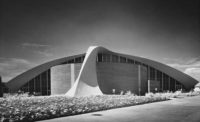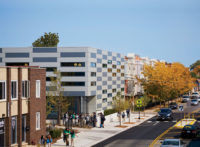True to the collaborative spirit of the progressive Sequoyah School, in Pasadena, California, its students played active roles in the recent architectural changes on campus. Architects Alice Fung and Michael Blatt asked the pupils at this independent K-8 school to list their 'wild dream' improvements and prioritize their needs. Their input had impact: Fung + Blatt Architects' (F+B) initial intervention here, in 2009, was a shaded pick-up/drop-off shelter, addressing a top priority of its users. The architects also tackled small projects, gradually weaving together the eclectic campus, before transforming a long-overlooked section with new buildings.
But the site'a 2.25-acre parcel between a freeway off-ramp and a major artery'is not an obvious spot for a school. Sequoyah leases its campus from Caltrans, the state highway agency, yet the school has flourished here for decades, striking a balance among seemingly irreconcilable conditions.
Originally, it was the site of an 1887 shingle-style church. In the early 1950s, California modernists Smith and Williams added Sunday-school buildings and a children's chapel, with grounds by Garrett Eckbo. In 1958, the newly founded Sequoyah School became the church's part-time tenant, occupying those classrooms the rest of the week. The design's flexible space and flow between indoors and out dovetailed with Sequoyah's philosophy. Amid trees, breezeways, and brise-soleils, each classroom was given its own yard, in addition to communal gathering spots.
But paradise was soon imperiled as the state planned to run the 710 Freeway through the site. California's Division of Highways eventually acquired the campus through eminent domain and, in 1974, bulldozed the church. Though the surviving buildings were, until recently, slated for demolition, the school stayed on as the tenant. Forty years after the church's demise, the freeway extension remains unrealized, largely due to community opposition. If completed, it will probably tunnel beneath this neighborhood.
With that likelihood, Sequoyah embarked on its own much-needed transformation, knitting together the mix of midcentury and shingle-style components within a new perforated-steel perimeter enclosure, designed by F+B to replace Caltrans's sagging chain-link barrier. 'This completely changed public perception of the school,' says Fung. 'It was a very smart, even strategic, move'demonstrating a stewardship of the campus that will, I hope, help Sequoyah purchase the property when it eventually comes on the market.' (Caltrans will presumably offer the campus for sale if it proceeds with its underground alternative.)
And it's an enclosure with transparency. 'Community is really important to us,' explains Sequoyah director Josh Brody. 'We wanted to convey that and also create inspiring gathering places, where we could hold events for students, parents, even the larger community.' That aspiration, coupled with Sequoyah's needs to provide performing arts facilities and expand its student body, from 190 to 250, led to re-envisioning a ragged end of campus, where trailers housed various school functions.
There, F+B formed an L-shaped configuration of three buildings, backed against the freeway off-ramp to deflect traffic noise and carve out a large, protected court. The $2.8 million, 11,700-square-foot project created classrooms, a science lab, and venues for gathering, art, and performance.
Echoing the spirit of Smith and Williams's design, F+B took conceptual cues from its breezeways, light-dappling sunscreens, and airy, daylit classrooms. With inverted trusses, shallow-pitched roofs, and deep overhangs extending into high, canted ceilings, the new wood-framed buildings reinterpret midcentury features, translating them with materials including fiber-cement siding and concrete flooring. Like their earlier counterparts, the classrooms are spacious and versatile, with movable partitions, lofts, and smaller 'learning pods' with their own outdoor verandas. Now art-making spills out onto a patio. A sliding panel opens the performing arts building, converting its indoor stage into an outdoor one. The students eat lunch together outdoors. 'We had no idea there was this much space back here or that it could be this great,' comments one eighth grader, sharing a typical reaction. And the sound-buffering buildings don't completely shun the freeway. Big classroom windows look straight down the traffic spine. As grade five-six teacher Art Phiffer explains, 'There's a lot to learn from the freeway, and we will be studying it.'
People
Client: Sequoyah School
Architect:
Personnel in architect's firm who should receive special credit:
Engineers:
Civil: Brandow & Johnston, Inc. Other: S.L. Leonard & Associates, Construction Manager
General contractor: AMG Associates, Inc. (expansion 2013); Mission Development Consultants (perimeter fence 2010); DTK Builders (shade structure 2009) Size: 11,700 square feet Project cost: $2.8 million Completion date: September 2013 |
Products
Structural system
Manufacturer of any structural components unique to this project:
Exterior cladding
Fiber Cement siding: James Hardie Building Products (Hardie panel, Hardie plank)
Roofing
Other:
Windows
Glazing
Doors
Wood doors:
Sliding doors:
Hardware
Closers:
Exit devices:
Other special hardware:
Interior finishes
Demountable partitions:
Cabinetwork and custom woodwork: Paints and stains: Sherwin-Williams Plastic laminate: Formica Solid surfacing: LivingStone
Floor and wall tile: Carpet: Tretford Tile
Furnishings
Lighting Downlights: Philips Lightolier Task lighting: Philips Lightolier
Exterior: Dimming System or other lighting controls: Hubell Building Automation
Conveyance
Plumbing Other unique products that contribute to sustainability: Invisible Structures Inc. (Rainstore3)
Add any additional building components or special equipment that made a significant contribution to this project: |
















Post a comment to this article
Report Abusive Comment